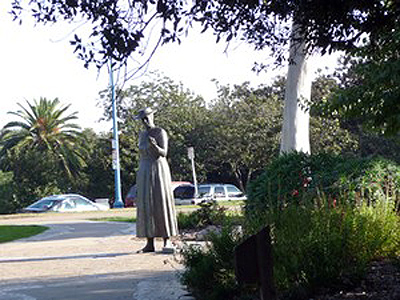
By Donald H. Harrison

SAN DIEGO—Today, Katherine Olivia Sessions (1857-1940) might have gotten an argument from conservationists who believe introduction of new plant species adversely impact the surrounding eco-system. However, in the late 19th and early 20th centuries, when San Diego was attempting to attract businesses and new residents, Sessions was highly admired for brightening San Diego’s horticultural palate by adding the colors of many imported plants to the normal browns and greens of the city’s native coastal chaparral.
Although she was born and educated in the San Francisco area, Sessions found her way to San Diego County where people say almost anything will grow if you just add water. She began her landscaping business in Coronado, but in 1892 moved to the mainland where San Diego’s political leadership traded her 30 acres for a nursery in what is now called Balboa Park, but then was known as City Park.
In return, Kate Sessions agreed to plant 100 trees a year to beautify the 1,400 acre urban preserve. Kate Her enthusiastic efforts eventually won her the title of “Mother of Balboa Park,” the nickname that is celebrated with the sculptor Ruth Hayward’s statue of her inside the park entrance near the corner of Sixth and Laurel.
A plaque lists Sessions occupations as those of “Scientist, horticulturalist, nurserywoman, ‘mother of Balboa Park,’” and goes on to inform that “Kate Sessions created gardens and landscapes for all to enjoy. In 1892 she began transforming the surrounding area from scrub-covered land into what is now Balboa Park. She introduced hundreds of our favorite plants and trees. Her vision continues to enrich our lives with beauty.”
Among the species Sessions planted in Balboa Park and elsewhere around the City of San Diego were Aleppo Pine, Banyan, Bird of Paradise, blue cypress, bougainvillea, Brazilian pepper tree, Carolina Yellow Jasmine, Italian Cypress, Poinsettia, Queen Palm, Star Jasmine, Twisted Juniper and Yellow Oleander. In honoring her in 1939 with its Frank Meyer Medal, the American Genetic Association said in over a half century of active work as a horticulturalist and landscape gardener, Sessions is “considered to be largely instrumental in making this great 1`,300-acre park the beauty spot that it is.”
“She has lost no opportunity to bring to her city those various plants she considered would thrive and adorn its parks and gardens,” a write-up by the American Genetic Association continued. “She was mainly responsible for bringing in the original plants of Cocos plumosa (Queen Palm) and the fine specimens in the San Diego Plaza were planted by her. She was one of the first—if not the first—to plant Bougainvillea spectabilis var. lateritia which covers so many of the houses and walls of her city with a riot of color. She first brought to public attention Ceanothus cyaneus (San Diego Mountain Lilac) and was also responsible for planting of the Succulent Garden in Balboa Park…”
East-West street names in the vicinity of Balboa Park register her influence. One never can get lost in this part of San Diego, so long as one remembers that the higher in the alphabet a street name is the farther north it is. The sequence, skipping “V” and ending at “W” includes Ash, Beech, Cedar, Date, Elm, Fir, Grape, Hawthorn, Ivy, Juniper, Kalmia, Laurel, Maple, Nutmeg, Olive, Palm, Quince, Redwood, Spruce, Thorn, Upas, and Walnut Streets.
As San Diego began readying the park for the 1915 Panama-California Exposition celebrating the opening of the Panama Canal—and expressing the hope that as the first U.S. port north of the canal San Diego would grow into an international trade depot—Sessions moved her nursery in 1910 to the nearby Mission Hills neighborhood, where a portion of it still stands and is celebrated as the oldest nursery in San Diego.
Sessions owned a home at the northernmost tip of Lark Street – a home that subsequently was demolished by the architect William Templeton Johnson, who designed the Serra Museum in Presidio Park, the San Diego Trust and Savings Bank at 6th and Broadway downtown, and what today is known as the San Diego Museum of Art in Balboa Park.
The home Johnson built at the Sessions site was acquired by the nearby Francis W. Parker School, a private school to the north of the property that he had helped to found. Subsequently, what is known as the Kate Sessions site was sold to UCSD physicist Charles Hicks, who recreated the William Templeton Johnson home on that property. Hicks said he believes some of the lush foliage around his home and in an adjoining canyon may be directly attributed to Sessions.
From Mission Hills, Sessions pushed on to the Pacific Beach area of San Diego, a neighborhood that really took her to heart. The 79-acre Soledad Terrace Park with a commanding view of both Mission Bay and San Diego Bay, was renamed as the Kate O. Sessions Memorial Park in 1958 to mark the just-passed centennial of her birth. Also named in her honor in this area are a residential street and an elementary school. The latter is particularly appropriate because Sessions at one time in her career was hired as the landscape architect for the city schools and also taught botany to high school classes.
At the northwest corner of Garnet Avenue and Pico Street in Pacific Beach is a state historical marker commemorating “the life and influence of a woman who envisioned a beautiful San Diego. On this site she operated a nursery and gained world renown. As a horticulturist, she was the first woman to receive the International Meyer Medal in genetics.”
*
Harrison is editor of San Diego Jewish World. This article appeared previously on examiner.com